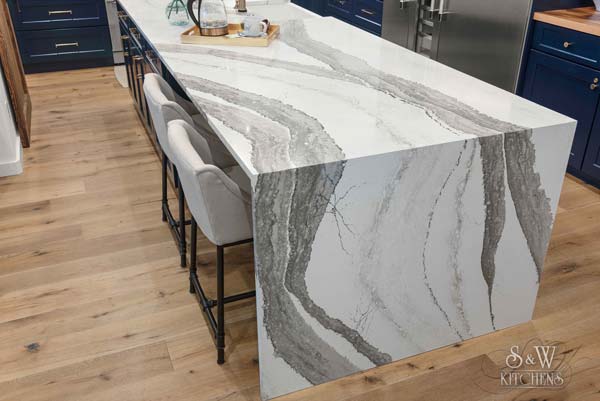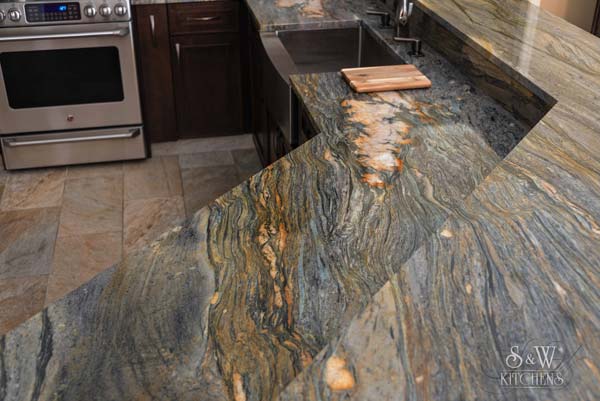Perhaps your kid’s science project on how stains are made went awry or that hot pan scorched your white kitchen countertop leaving a brown spot for everyone to notice. Whatever kitchen calamities have occurred, your kitchen countertops have likely endured many years of use and probably some abuse. And when you make that decision to remodel your kitchen, that is the time to talk about countertop materials.

Before the age of synthetics, the choices of countertop materials were two: wood and stone. But today, thanks to some technical development and some innovative chemistry the choices are many.
Countertop Material Options
Let’s look at a few choices that are on the market today:
Tile is a traditional countertop material. It comes in many patterns, but it can crack and can be damaged by a hot pan placed on it. Even if you choose a different countertop material, tile can be used for the kitchen backsplash.
Wood and the popular butcher block type countertops are also traditional choices. They are beautiful and timeless, but they require regular maintenance and sealing and are easily damaged by water.
Synthetic stone countertops like Corian are the result of modern chemistry. They are made with acrylics and polyesters or both, and in some ways are superior to natural stone. Invented in 1967 by a chemist from Dupont, it is now available in over 100 colors. The biggest problem with Corian is that it is not resistant to moisture and that can be an issue with under-mounted sinks. It is less expensive than natural stone.
Laminates are another great choice for countertops. They are made from layers of plastic that are bonded to particleboard or another substrate. They are affordable and relatively easy to install. Laminates need to be sealed to minimize chipping and scratching. While not as durable as granite, they will still have a lifetime of 10 to 15 years. The best feature of laminates is that they can mimic the appearance of just about any material including marble and even stainless steel.
While not that common, stainless steel countertops can give that “industrial chic” look with its silvery sheen. It has seen a slight rise in popularity for those who want to emulate the kitchens in cooking shows and who want a professional or commercial kitchen look. Stainless steel is durable and easy to clean. The main drawbacks are that it can be scratched by stainless steel cutlery and it is not an option for someone seeking an inexpensive countertop replacement.
Concrete is not just for foundation slabs and driveways. As a countertop material, it can give an appearance like stainless steel, but it will have the feel of a natural stone surface. The installation will require a skilled craftsman and the countertop will need regular maintenance. Exposed concrete can be damaged by weak acids like vinegar (acetic acid) and citric acid in soft drinks and citrus fruits. Sealing and waxing will help prevent damage and stains.
If you are looking for the best of both worlds, consider engineered quartz as your choice of countertop material. The material is about 90% quartz that is ground into a powder and mixed with about 10% resins and pigments and then formed, into durable and non-porous slabs. It is resistant to scratches, dents, and it can handle orange juice and pickle juice with no need for any sealants. Common brand names for engineered quartz are Cambria, Silestone, and Caesarstone that all offer a wide variety of colors and textures. It is less expensive than natural stone. Engineered quartz is not as resistant to heat so the cook in your family will need to use a trivet or a potholder to protect the countertop and it is not recommended for outdoor use. Finely honed surfaces will tend to show fingerprints, but a little soap and water will take care of them in quick order.
Last are the stone countertops. They are expensive but will add long-lasting beauty and value to your kitchen. Granite, quartz, soapstone, and slate are among the stone countertop options that will turn any countertop into a stylish and durable kitchen feature.

Note that granite and marble are heavy materials and the raw slabs will need to be cut to a precise measurement for proper installation. Be sure that the existing supporting structure and cabinets are braced to handle the added weight. Keep in mind that specially ordered materials like granite or other natural stone may not be immediately available and it can take one to three months and possibly longer to get it.
Hire a Professional for the Best Results
Any home remodeling job can be stressful and unlike a living room or bedroom remodel there may be electrical and plumbing issues to consider with a kitchen. Hiring a professional, especially for the heavier stone materials is strongly recommended for a countertop that will be the envy of your neighborhood.
https://countertopguides.com/materials.html
https://www.oldhouseonline.com/kitchens-and-baths-articles/best-countertop-choices-old-house-kitchens
https://www.remodelista.com/posts/remodeling-101-engineered-quartz-countertops/
